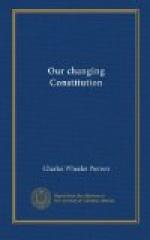[Footnote 1: Since this chapter was put into print the Court has spoken. In Bailey v. The Drexel Furniture Co. (decided May 15, 1922) the Child Labor Tax Law was pronounced unconstitutional. The Court, while conceding that it must interpret the intent and meaning of Congress from the language of the act, held that the act on its face is an attempt to regulate matters of state concern by the use of a so-called tax as a penalty. The opinion of the Court, written by Chief Justice Taft, is an emphatic assertion of the duty and function of the Court to preserve the constitutional equilibrium between nation and states.]
VII
STATE RIGHTS AND THE SUPREME COURT
A century ago the United States Supreme Court was the bulwark of national power against the assaults and pretensions of the states. To-day it is the defender of the states against the encroachments of national power. Let no one suppose, however, that this is because the Court itself has faced about. On our revolving planet a ship may be sailing toward the sun at sunrise and away from the sun in the afternoon without having changed its course. The Supreme Court has been the most consistent factor in our governmental scheme. While there have been differences of viewpoint between liberal constructionists and strict constructionists among its members, the Court on the whole has steered a fairly straight course. What has really altered is the environment in which the Court moves. The earth has been turning on its axis. The frame of mind of the people who compose states and nation has changed.
At the outset (to cling for a moment to our nautical metaphor) the Court was obliged to put forth on an unknown sea. Its sailing orders under the new Constitution were unique. Precedents, those charts and lighthouses of the judicial mariner, were lacking. Progress was tentative and groping. Little wonder therefore that at first the business of the Court was meager and membership in its body seemed less attractive than membership in the judiciary of a state. Robert Hanson Harrison, one of President Washington’s original appointees to the Supreme bench, declined to serve, preferring to accept a state judicial office. John Rutledge, another of the original appointees, resigned after a few months, preferring the position of Chancellor of his native state to which he had been chosen. John Jay, the first Chief Justice, resigned to become Governor of New York, and later declined a reappointment as Chief Justice in words indicating entire lack of faith in the powers and future of the Court.




